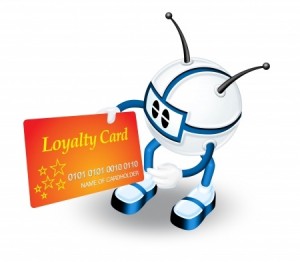A land flowing with milk and data…

One of the obvious existing “information markets” is the world of consumer loyalty schemes. Major loyalty schemes, such as those of Boots, Tesco, and the multi-retailer Nectar scheme are explicitly exchanging points for information. Whilst few people know what a point is actually worth (and that’s because it’s not easy to know, but that’s another story) a lot of people seem to think that giving details of their shopping behaviour to a retailer, or group of retailers is worthwhile in terms of the value they receive in return. And the retailers certainly seem to think that the data they receive is more than worth the value they give to customers in exchange.
Aimia, the almost completely unknown company that is behind the UK’s Nectar loyalty scheme, as well as many other loyalty programmes around the world, have recently reported the results of a pretty comprehensive survey of our attitudes to loyalty programmes. The headline figures look good: In 2013, 87% of UK consumers are members of one or more loyalty schemes, and £1 of every £7 spent involves a loyalty programme of one sort or another (twenty years ago it was £1 in every £100).
But underneath the headlines the research suggests that people are increasingly concerned about the deal they’ve entered into, are not sure they want to continue, and are waging a kind of guerrilla information war to address their concerns.
For instance, 73% of survey respondents said they felt that companies weren’t clear in their explanations about how their personal information was going to be used, and by whom.
And 76% of respondents believe that the data isn’t being used to benefit the customer, but only to target advertising at people, or simply for the company to sell it on to someone else.
Those concerns, which might be glossed as saying that customers don’t believe that the reward they get in return for giving access to their personal information represents a fair exchange, leads some customers to take “direct action”:
Overall, 4 out of every 10 customers (38%) said they provide false details to avoid giving away their personal information. But that varies quite markedly depending on the age of the respondent. Amongst the youngest consumers, the 18-24 year old age group, that rises to 1 in every 2 (48%) customers providing false data. Amongst the over 65’s only 18% admitted to giving false data. Of those who said they make up personal details, 72 per cent said they did so to avoid then being contacted, but 42 per cent said they did it because they believe that the information being asked for is private.
That level of rogue data must raise real concerns about the quality of the data loyalty schemes are gathering, and of the value of the analyses that they then provide to the retail organisations to guide their sales and marketing efforts.
Another way of putting that is to note that no matter how little an organisation gives for information, if that information is false then they are paying an infinitely high price. Rather than trying to continue operating with a contract/exchange that is widely perceived to be unfair and which is therefore “fair game” for attempts to circumvent and abuse it, a better strategy would be to negotiate a basis for the exchange of information that is seen by both parties as fair and worthwhile.
One of the things the report notes is that the supermarkets and retailers have emerged as the most successful exponents of loyalty schemes. Given the apparent overall prevalence of false data then it might be that that success is based on the fact that the key data for supermarkets is unfalsifiable: did you or didn’t you buy product x, how much of it did you buy, how often do you buy it, and when you buy it what else do you buy? And this transaction data is a particularly interesting kind of personal data. It can be argued that transaction data belongs as much to the retailer as to the customer: one creates data by buying, the other by selling. The key things a customer does when they sign up to a loyalty programme is, on the one hand, provide a means of identification that allows retailers to link purchase patterns over time and across multiple purchases, and on the other it gives the retailer permission, and the information they need to allow them to talk to the customer about what they have bought, and about what they might buy next time.
The research also looked at which kinds of data were most, and least, happy to provide to loyalty programmes.
And here are the results that show what percentage was happy to provide what type of data:
Name (49%
Hobbies (48%)
Email address (45%)
Income (23%)
Postal address (22%)
Web history (tracking) (21%)
Mobile phone number (17%)
These are really interesting differences, suggesting that an important characteristic of personal data is that what counts as personal, and exactly how personal (intimate) it is varies considerably. If we are going to make progress in debating and deciding how personal data can be used an important implication here is that not all personal data is equal, and that we need to recognise those differences and their implications.
The research also looked at which organisations are most trusted with personal data. Here are the results which show the average “happy to provide” using a rating of 0-10 for each type of organisation.
Banks and financial services (8.2)
Place of work (6.9)
Supermarkets (6.7)
Utility companies (6.1)
Telecom companies (5.9)
Online retailers (5.6)
Government agencies (5.3)
Loyalty programmes (5.3)
Social networks (2.6)
Online search engines (2.5)
These are, I think, pretty surprising results. The most trusted organisations include the banks and the utility companies, who have seen their reputations shredded over the last few years, and who attract considerable hostility from consumers. And yet we seem to be quite happy to provide them with our personal data. At the other end of the scale we have social networks, such as Facebook, and search engines such as Google, which have exploded from nothing to worldwide mega-corporations because millions of people seem to love the services they provide. And they provide those services in exchange for access to and on the understanding that they will exploit users’ personal data in various ways. Why then are these the kinds of organisations that we are least happy to provide our data to? More research is clearly needed to understand what is going on here!
Finally, I think the commentary supplied by Aimia on their research makes interesting reading. Their
Legal Director, Jeremy Henderson-Ross is quoted as saying that the survey findings “underlined the importance of transparency around data sharing.”
“Transparency is the most important thing for companies to get right. When customers understand what their data is being used for – and what they will get in return – they are more willing to share.”
He then went on to claim that Nectar “has achieved a high level of trust because customers know data is never shared outside the Nectar family.”
I’m not at all sure that he’s right about that. Firstly that it has achieved a high level of trust: his own data shows that loyalty programs score just 5.3 on a 0-10 scale, and ranks 8th out of 10 kinds of organisations. I’m not sure that that demonstrates “a high level of trust”. And secondly that customers know how Nectar uses their data: that the whole point of multi-retailer loyalty schemes is that they share information amongst all of the client members of that scheme. I’m not at all sure that Nectar members know that analyses of their transactions with, say, Ladbrokes the bookmakers might be made available to Experian the credit rating agency, or that Genes Reunited are sharing their data with Match.com. And I’m not at all sure that they’d be happy when they did!




















